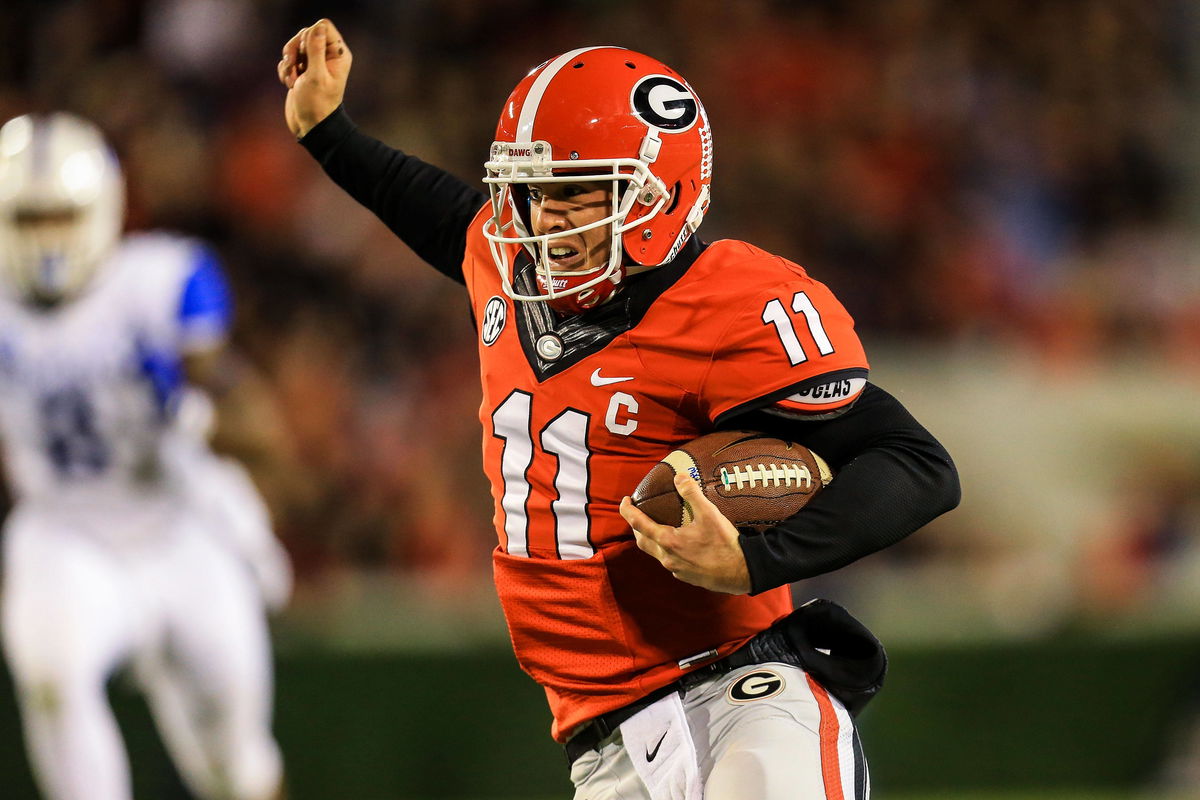
Imago
NCAA, College League, USA Football: Kentucky at Georgia Nov 23, 2013 Athens, GA, USA Georgia Bulldogs quarterback Aaron Murray 11 runs the ball in the first half against the Kentucky Wildcats at Sanford Stadium. Athens Sanford Stadium GA USA, EDITORIAL USE ONLY PUBLICATIONxINxGERxSUIxAUTxONLY Copyright: xDanielxShireyx 7573795

Imago
NCAA, College League, USA Football: Kentucky at Georgia Nov 23, 2013 Athens, GA, USA Georgia Bulldogs quarterback Aaron Murray 11 runs the ball in the first half against the Kentucky Wildcats at Sanford Stadium. Athens Sanford Stadium GA USA, EDITORIAL USE ONLY PUBLICATIONxINxGERxSUIxAUTxONLY Copyright: xDanielxShireyx 7573795
You don’t see an ESPN analyst and former Georgia star asking for help on social media. But that’s exactly what happened when Aaron Murray, the former quarterback for the Georgia Bulldogs and now voice of the SEC Network, moved to X after YouTube abruptly took down his YouTube channel, Mac & Murray CFB Show. Fans were outraged that a reputable expert had to plead for a fair evaluation publicly, but Murray argues the channel exclusively offers original college football discussion.
Watch What’s Trending Now!
After Murray’s post became viral on X, he tagged @TeamYouTube and @YouTubeCreators in the hopes of receiving a genuine human evaluation. He clarified in his statement that The Mac & Murray CFB Show is not a spam page but rather a legitimate college football podcast and analysis channel. Through his weekly previews, video analysis, and in-depth conversations about the sport, the program has built up an impressive following, with 30,000 subscribers, verified guests, and ESPN analysts showing up.
30,000 subscribers. Verified guests. ESPN analysts.
Our Mac & Murray CFB Show channel was terminated for “spam,” even though we only post original college football coverage.@TeamYouTube — we just want a fair, human review. @YouTubeCreators #CollegeFootball fans, please help… https://t.co/73dLMR7hbP
— Aaron Murray (@aaronmurray11) October 13, 2025
ADVERTISEMENT
Actually, YouTube’s team replied after reviewing the tweet, stating, “Thanks for bringing this to our attention. Passing this along to our team for a closer look now.” Even fans came up quickly with their own theories. Some pointed out that YouTube has recently tightened its policies on anything that even somewhat looks like gaming clips or links to promotions.
Others said that after posting brief highlight clips or including referral links in their descriptions, they had experienced similar takedowns. Some joked that the person who hit the report button on his channel must have been “an Auburn fan at Google,” but most people agreed that it’s just another instance of automatic monitoring gone too far.
And the fact that Aaron Murray isn’t just any random creator trying to get into sports media; he’s one of Georgia’s all-time greats. The former quarterback for the Bulldogs still leads Peyton and Eli Manning in the SEC with 13,166 passing yards and 121 touchdowns. Murray has transitioned into broadcasting after a brief NFL career with clubs like the Chiefs and Eagles and stints in the AAF and XFL until 2020, when the XFL suspended its operations. Since then, he has been a regular face on the SEC Network and was a member of ESPN’s coverage staff. Murray’s path from the football field to the mic shows why so many people are supporting him; it’s not just a channel; his career and passion are at stake.
ADVERTISEMENT
Aaron Murray’s channel takedown highlights the digital struggle for CFB creators
Aaron Murray’s YouTube channel being taken down reflects a bigger shift in college football media. Former players are now creating their own channels, podcasts, and digital brands where fans can get more detailed clip analysis, game previews, and firsthand insights from the players themselves. It’s not just Murray, though; stars like Urban Meyer and Colin Cowherd have used their experience to create shows and podcasts like The Colin Cowherd Podcast. Kirk Herbstreit and Lee Corso have also adapted to social media and YouTube videos to remain relevant. Joel Klatt has turned his experience as a quarterback in Colorado into The Joel Klatt Show.
ADVERTISEMENT

Imago
NCAA, College League, USA Football: Georgia at Clemson Aug 31, 2013 Clemson, SC, USA Georgia Bulldogs quarterback Aaron Murray 11 watches a replay on the sidelines during the fourth quarter against the Clemson Tigers at Clemson Memorial Stadium. Clemson defeated Georgia 38-35. Clemson Clemson Memorial Stadium SC USA, EDITORIAL USE ONLY PUBLICATIONxINxGERxSUIxAUTxONLY Copyright: xJeremyxBrevardx 7411053
The issue is that these systems aren’t always configured for it. Consider Brett Kollmann, who had one of his lengthy, well-produced NFL draft videos flagged for infringing content by XOS Digital in May 2025. Even though the videos were meant to evaluate players, Content ID automatically reported them, and sent a similar threatening e-mail to remove his video and strike his account. Fans and independent analysts frequently feel that the laws are stacked against them, and this is an obvious example of how automatic copyright procedures may compromise creators’ work, even when it is obviously their original work.
This is especially important for football content since, unlike music or movies, fans and analysts cannot legally view full plays freely online. YouTube and similar platforms must strike a balance between supporting creators and rights-holder pressure, but their automated systems frequently make errors in judgment. While the major leagues continue to dominate highlights and game footage, CFB fans will lose reliable voices like Murray’s channel or Kollmann’s video. In an era where college football reports are increasingly being created online, these takedowns highlight how vulnerable that system can be for analysts trying to connect with fans.
ADVERTISEMENT
ADVERTISEMENT
ADVERTISEMENT
ADVERTISEMENT

